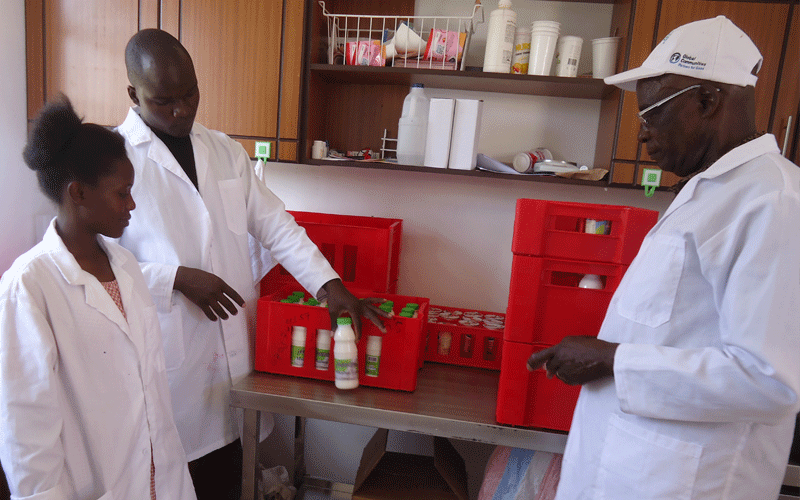Farmers bet on chilling plants to boost yields

Dairy farmers in Homa Bay and Kisumu counties are betting on newly established milk chilling plants to increase productivity.
Milk chilling plants in Muhoroni and Kasipul sub-counties are already improving access to the dairy market as well as promoting safe and nutritious milk consumption locally.
The Osiepe Practical and Kasbondo milk handling facilities were established courtesy of a partnership between the farmers’ cooperative and USAid agricultural programme christened Accelerated Value Chain Development (AVCD). Kasbondo is ran by Kasbondo Aim Dairy Cooperative Society and has a capacity of 5,000 litres.
The facility collects on average 400 litres of milk from farmers who are paid Sh48 per litre on a weekly or monthly basis depending on one’s choice.
The plant, which was commissioned two years ago, processes between 800 and 1,200 litres of milk per day.
Kasbondo Dairy Co-operative Secretary Okal Okoko says the chilling plant offers dairy farmers a ready market for their produce.
“The plant has relieved dairy farmers who no longer have a problem getting access to market for their produce,” he says.
The collection centre pasturises milk and also makes yoghurt for sale to residents.
“The farmers benefit from subsidised Artificial Insemination (AI) services, exchange visits on dairy production matters organised by the cooperative development partners besides getting subsidised fodder planting materials,” says Okoko.
Muhoroni Bulk Milk Collection Centre is owned and managed by Osiepe Practical Action, an agricultural Community-Based Organisation (CBO).
The 5,000-litre capacity chilling plant processes between 300 and 500 litres of milk.
Muhoroni farmers supply about 200 litres per day while the rest come from neighbouring regions of Nandi county.
Farmers earn Sh45 a litre while the plant sells the cooled and packed milk in bulk at Sh50 or Sh55 per litre on retail.
The facility sells between 200 and 400 litres daily through selected milk vendors in the area.
Production manager Emmanuel Omondi says 34 dairy farmers regularly supply the plant with milk. “We get between five to 15 litres from every farmer daily,” he says.
According to Hezekiah Omenda, the CBO chairman, the facility is a major boost to dairy farming in the area.
“With the setting up of the milk chilling plant, we are rallying on a collective transformation plan to improve the lives of dairy farmers locally,” he says.
The group is also undertaking interventions such as encouraging improved animal breeding concepts and use of superior forages (such as brachiaria grass) to bridge the area’s deficit in milk production.
And through sensitisation forums, the CBO is promoting modern dairy practices to enhance yields.
“We want farmers to be dairy ready; each home should produce a minimum of 10 litres of milk daily,” says Omenda.
The plant is on a growth path, with plans to start value addition by processing milk in the coming years.
“We plan to turn the facility into a milk-processing industry in two to three years,” he says.
The milk production cycle starts with collection of milk from each farmer. The milk is taken to the lab for quality testing before being subjected to a weighing machine to determine the number of litres.
The milk is then pasteurised before it is cooled and finally preserved at the chilling tank to extend its self-life.
“Currently, we only sell fresh milk, but plans are underway to start producing other by-products such as yoghurt and mala,” says Omondi.
The two counties are yet to realise milk sufficiency with the on-going interventions. Kisumu for instance suffers from chronic milk deficit and relies on imports from other counties.
Production cycle
Data from the Kisumu Directorate of Livestock shows that the county produces about 33 million litres of milk annually—at about eight litres per cow daily.
The annual per capita milk consumption of the county is at 28 litres, way below the minimum recommended national average of 110 litres.
Unreliable weather patterns that result to feeds scarcity particularly drought, farmers’ access to quality dairy cows and keeping of traditional breeds (zebus) which produce low yields are the major challenges facing dairy farming in the county.
Kisumu county director of Livestock production Charles Kakuku says the county is promoting dairy value chain by introducing new technologies geared towards boosting the genetic pool of their dairy cattle.
“We are also collaborating with donors to promote use of improved fodders, which are drought tolerant and disease free,” he says.
Kakuku says exotic breeds are not native to Kisumu county. “We are building on gene development through more capacity building around exotic dairy keeping,” says Kakuku.
The agricultural officer says there is hope the new chilling plants will boost the county’s milk output.
“We anticipate the chilling plant will trigger interest in dairy farming, hence improve our annual productivity,” he notes.
He urges farmers to begin practising dairy farming for commercial purposes and embrace new farming technologies to enhance production. “Kisumu has a good potential for dairy production,” he adds.












